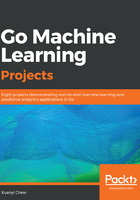
What is machine learning?
So what then is ML? As the word may hint, it's the ML to do something. Machines cannot learn the same way as humans can, but they can definitely emulate some parts of human learning. But what are they supposed to learn? Different algorithms learn different things, but the shared themes are that the machines learn a program. Or to put in less specific terms, the machine learns to do the correct thing.
What then is the correct thing? Not wanting to open a philosophical can of worms, the correct thing is what we, as human programmers of the computer, define as the correct thing.
There are multiple classification schemes of ML systems, but amongst the most common classification schemes, is one that splits ML into two types: supervised learning and unsupervised learning. Throughout this book we will see examples of both, but it's my opinion that such forms of classification are squarely in the good to know but not operationally important area of the brain. I say so because outside of a few well-known algorithms, unsupervised learning is still very much under active research. Supervised learning algorithms are too, but have been used in industry for longer than the unsupervised algorithms. That is not to say that unsupervised learning is not of value—a few have escaped the ivory towers of academia and have proven to be quite useful. We shall explore K-means and k-Nearest Neighbors (KNN) in one of the chapters.
Let's suppose for now we have a machine learning algorithm. The algorithm is a black box - we don't know what goes on inside. We feed it some data. And through its internal mechanisms, it produces an output. The output may not be correct. So it checks for whether the output is correct or not. If the output is not correct, it changes its internal mechanism, and tries again and again until the output is correct. This is how machine learning algorithms work in general. This is called training.
There are notions of what "correct" means of course. In supervised learning situations, we, the humans provide the machine with examples of correct data. In unsupervised learning situations, the notion of correctness relies on other metrics like distances between values. Each algorithm has its own specifics, but in general machine learning algorithms are as described.